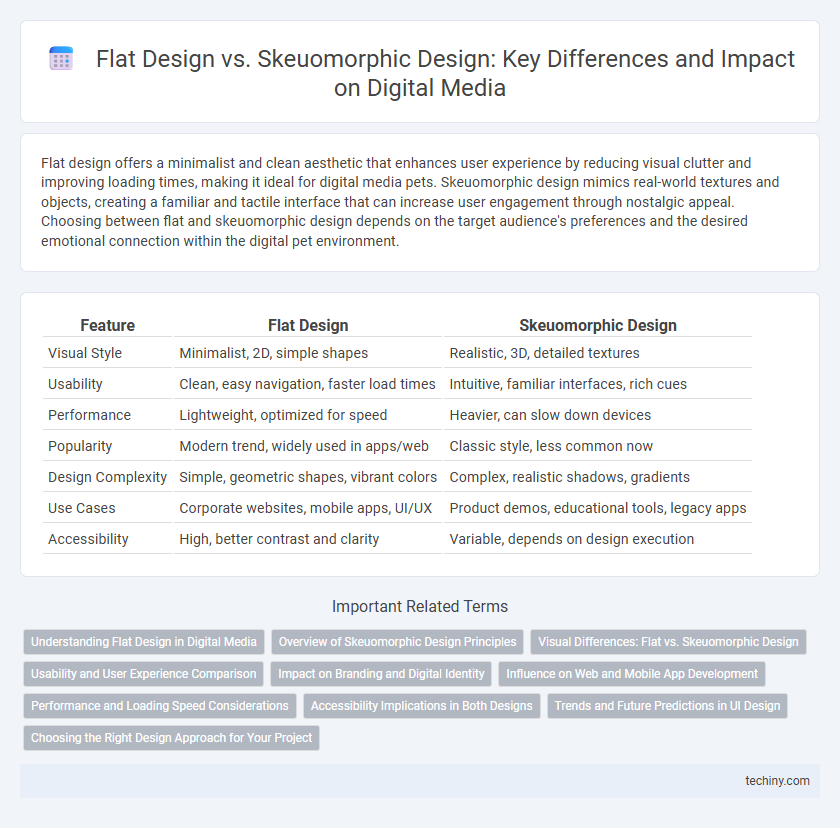Flat design offers a minimalist and clean aesthetic that enhances user experience by reducing visual clutter and improving loading times, making it ideal for digital media pets. Skeuomorphic design mimics real-world textures and objects, creating a familiar and tactile interface that can increase user engagement through nostalgic appeal. Choosing between flat and skeuomorphic design depends on the target audience's preferences and the desired emotional connection within the digital pet environment.
Table of Comparison
| Feature | Flat Design | Skeuomorphic Design |
|---|---|---|
| Visual Style | Minimalist, 2D, simple shapes | Realistic, 3D, detailed textures |
| Usability | Clean, easy navigation, faster load times | Intuitive, familiar interfaces, rich cues |
| Performance | Lightweight, optimized for speed | Heavier, can slow down devices |
| Popularity | Modern trend, widely used in apps/web | Classic style, less common now |
| Design Complexity | Simple, geometric shapes, vibrant colors | Complex, realistic shadows, gradients |
| Use Cases | Corporate websites, mobile apps, UI/UX | Product demos, educational tools, legacy apps |
| Accessibility | High, better contrast and clarity | Variable, depends on design execution |
Understanding Flat Design in Digital Media
Flat design in digital media emphasizes minimalism with clean, two-dimensional elements, bold colors, and simple typography to enhance user experience and interface clarity. This design approach reduces visual clutter, improving load times and responsiveness across devices, which is crucial for mobile and web applications. Prioritizing functionality and intuitive navigation, flat design supports modern digital trends by promoting faster interaction and accessibility.
Overview of Skeuomorphic Design Principles
Skeuomorphic design principles emphasize replicating real-world textures, materials, and objects to create intuitive user interfaces that mimic physical counterparts, enhancing user familiarity and engagement. This approach uses depth, shading, and detailed visuals to provide tactile cues and a sense of realism, distinguishing interactive elements clearly. Skeuomorphism often prioritizes embellishment and ornamental details, contrasting with the simplicity and minimalism found in flat design.
Visual Differences: Flat vs. Skeuomorphic Design
Flat design features clean, minimalistic visuals with bold colors, simple shapes, and no textures, emphasizing usability and clarity in digital interfaces. Skeuomorphic design replicates real-world textures, shadows, and intricate details to create a lifelike appearance, enhancing user familiarity through visual realism. The contrast between flat design's abstraction and skeuomorphism's realism significantly impacts user perception and interaction within digital media environments.
Usability and User Experience Comparison
Flat design emphasizes simplicity and minimalism, enhancing usability by reducing visual clutter and improving load times, which results in faster navigation and clearer user interfaces. Skeuomorphic design mimics real-world textures and objects, offering a familiar and intuitive experience that can ease user onboarding but may increase cognitive load due to detailed graphics. In user experience comparisons, flat design supports efficiency and scalability across devices, while skeuomorphic design excels in creating emotional connections through recognizable, tactile elements.
Impact on Branding and Digital Identity
Flat design enhances branding and digital identity by promoting simplicity and clarity, resulting in faster load times and improved user experience across devices. Skeuomorphic design builds emotional connections and familiarity through realistic textures and elements, reinforcing brand storytelling and recognition. Choosing between these styles affects audience perception and engagement, influencing how a brand distinguishes itself in competitive digital landscapes.
Influence on Web and Mobile App Development
Flat design simplifies user interfaces by emphasizing minimalism, clean lines, and vibrant colors, which enhances loading times and responsiveness in web and mobile app development. Skeuomorphic design mimics real-world textures and objects, offering intuitive user experiences through familiar visuals but often increases complexity and resource usage in digital projects. The choice between flat and skeuomorphic design significantly impacts usability, performance, and development efficiency, guiding trends in mobile app and website creation.
Performance and Loading Speed Considerations
Flat design significantly improves performance and loading speed due to its minimalistic use of elements and simple vector graphics, reducing file size and rendering time. Skeuomorphic design, often relying on complex textures and detailed imagery, typically demands more resources, leading to slower load times and increased bandwidth consumption. Optimizing digital media with flat design principles ensures faster user experiences and better efficiency across various devices and network conditions.
Accessibility Implications in Both Designs
Flat design enhances accessibility by using clear typography, simple icons, and high-contrast colors that improve readability and reduce cognitive load for users with visual impairments. Skeuomorphic design, while visually rich and familiar, can introduce complexity and clutter, making it harder for screen readers and users with cognitive disabilities to navigate interfaces efficiently. Prioritizing minimalist flat design principles often results in more inclusive digital media experiences by ensuring consistency and ease of interaction across diverse user needs.
Trends and Future Predictions in UI Design
Flat design emphasizes minimalism and bold colors, dominating recent UI design trends due to its simplicity and faster load times on digital platforms. Skeuomorphic design, which mimics real-world textures and objects, is seeing a subtle resurgence aimed at enhancing user familiarity and engagement in specific applications like digital learning and accessibility tools. Future predictions suggest a hybrid approach, blending flat design's efficiency with skeuomorphism's intuitive affordances to create more immersive and user-friendly interfaces.
Choosing the Right Design Approach for Your Project
Flat design emphasizes simplicity and minimalism, using bold colors and clean typography to enhance user experience through intuitive navigation and faster load times. Skeuomorphic design mimics real-world textures and objects to create familiarity and visual depth, appealing to users who prefer tangible interactions. Evaluating your project's target audience, goals, and platform constraints will help determine whether flat or skeuomorphic design aligns best with your digital media strategy.
Flat Design vs Skeuomorphic Design Infographic

 techiny.com
techiny.com